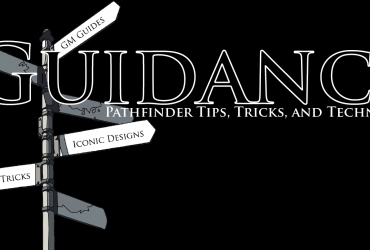Recently, I’ve been writing about experimenting with Pathfinders rules with inspiration coming from outside the Pathfinder rules entirely and some with the optional rules from sources such as Pathfinder Unchained. So what about experimenting with the existing game rules? Often this means making small changes rather than sweeping alterations, but it could be that the change you want might require significant work.

Paizo Goblin: Andrew Hou
One change I implemented some time ago and have had a lot of success with is a small tweak to the initiative rules. In my games, I no longer roll initiative for NPCs. Each NPC has an initiative score equal to 11+ its initiative modifier. I find that not having to worry about my own dice rolls allows me to get everyone’s place in the round quickly recorded and gets us right into the action. This could be expanded to include PC allies such as animal companions and hirelings easily.
Another advantage to this system is that occasionally an adventure calls for an NPC to be really alert or not. I can think of a particular pair of goblins from a published adventure: one sleeping, the other “artistically” shoving food in her companion’s ear. Giving the artist a -4 to her initiative score helps establish how little attention she was paying. Conversely, if an encounter happens in a dungeon on high-alert, you could give the creatures in encounters immediately following the alarm a +2 bonus to their initiative scores. The point of this house rule was originally to just help me speed up combat but the narrative advantages quickly became obvious and I have employed them on several occasions.
I find that it is best to decide what you want the rules to accomplish and figure out where they aren’t living up to your needs. In the above example, I wanted to streamline combat and beginning with initiative seemed like a small easy to reverse change in case it didn’t work. Removing a few dice rolls and having it mostly mimic the existing AC and CMD rules seemed like a logical starting point. For another example, a friend of mine really hates (as a GM and player) the swarm rules particularly in regards to swarms of fine and smaller creatures.

Jonathan Hyde in The Mummy, Universal Studios
He doesn’t like the idea that you can’t crush such creatures under your boots or swat them when they’re perched on your arms or torso. One solution we plan to playtest soon is to change the swarm’s immunity to all weapon damage to an immunity to slashing and piercing weapon damage. We’ll also grant crawling swarms DR 10 and flying (or swimming) swarms DR 15. For swarms that already have an un-typed DR increase it by 5 for crawling swarms and 10 for flying swarms. Another possible solution (and one we may employ simultaneously) is to add a crush combat maneuver you can attempt only against swarms of fine or smaller creatures. Either way, we’ve identified the problematic mechanic and have a few ideas for how to fix them.
One of my other pet peeves with Pathfinder isn’t so much a problem but an opportunity. The sheer number of options available right now means that most players will not get to play with even a fraction of the feats they’d like to try out. Well, someone like me with limited time to game won’t get to play with all the shiny options they’d like to. So house rules to expand what’s available to PCs to play with.
- What if a character could forgo 3 or 4 skill ranks to master a feat they qualify for?
- What if characters could spend gold and time for advanced training that would allow them to acquire new skill ranks or feats in lieu of magic items?
- What if instead of increasing an attribute a PC could gain a new feat or variant racial trait?
If I allow my players to buy feats with gold or skill points and discover down the line that the game’s balance has been disrupted, my players and I need to have an agreement up front as to how we’ll handle the situation. Sometimes your mechanics just don’t work out. Make sure if you are playtesting a new rule that you and your players have an exit strategy. You don’t want to torpedo a perfectly good campaign because your new mechanics don’t work out.







one option I am trying in my next game is this http://theworldissquare.com/feat-taxes-in-pathfinder/ should allow people more choices in feats instead of having to always take certain ones to be viable
That’s a good article. Thanks for sharing it.
My last game we played with a houserule of taking a feat every level instead of just odd levels. the party did get pretty powerful and balancing encounters got difficult for me. I was hoping to see more unusual feat chains completed but what they took was all the generic beneficial feats like improved initiative, iron will, toughness, dodge, etc.
I guess it depends on the creativity of the players and how dedicated they are to their gimmick.
I suppose if you were to try that particular experiment again you could make a rule that any of the extra feats can’t be combat feats or that if they are working on a feat chain they must wait x number of levels before buying the next feat in the chain. The power issue was why I was looking at balancing it out by making the players expend some other resource whether it be an ability score boost or a bit of gold.